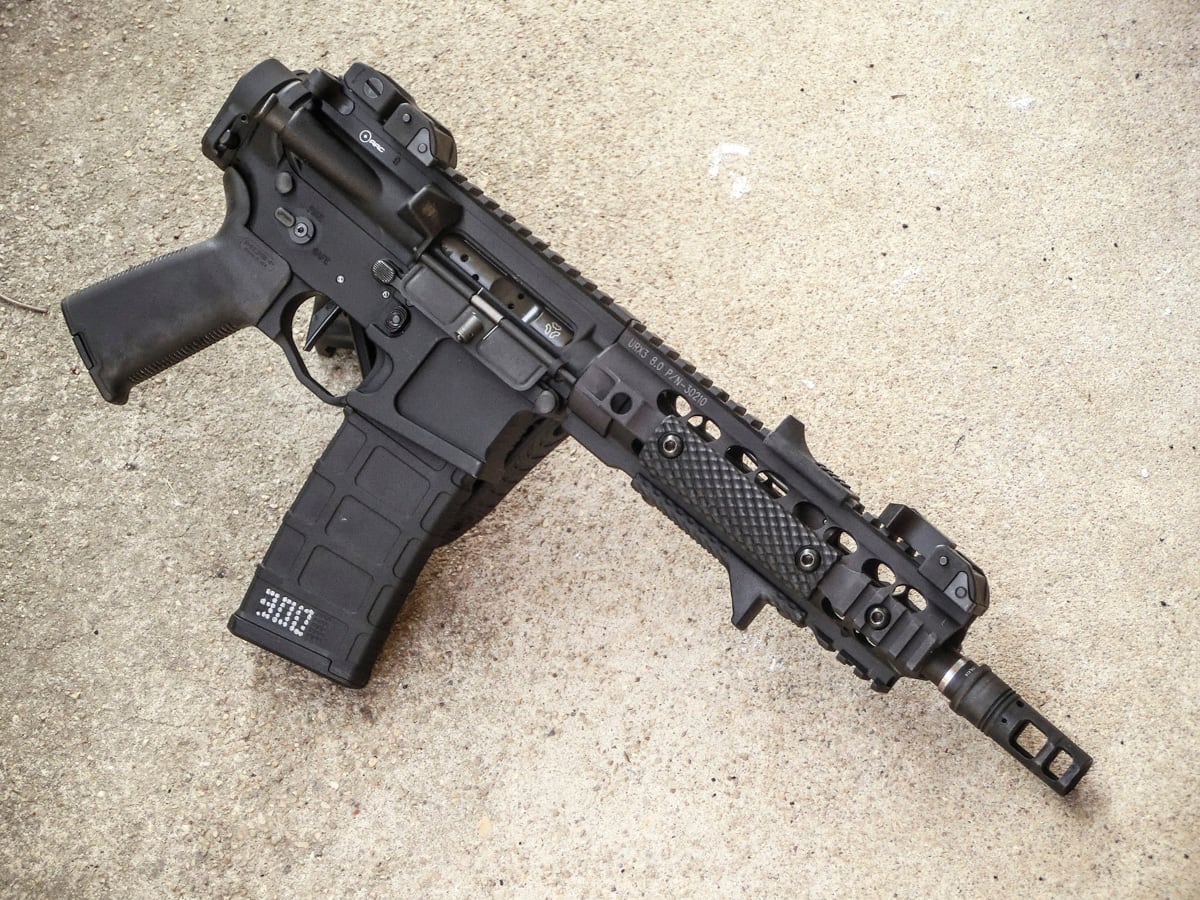Law Tactical's Gen 2 AR Folding Stock Adapter was already a peerless solution for anyone looking to reduce the visual signature of an AR15 or AR10 rifle during transport. The single largest contributor to its success is the fact that it doesn't change the operation of the AR or affect compatibility with existing AR parts.
Sure, the FSA adds a little weight and extends the length of pull by 1.375", but when used normally, the part is nearly transparent to the rifle's operation. We're glad to see the new Gen3 update brings with it enhanced ergonomics, easier maintenance and greater durability without sacrificing any aspect of the FSA's core capability.

[HTML1]
All Steel Construction: The most obvious change going from Gen2 to Gen3 is the use of a steel body. Gen2 had an aluminum body with a steel blocking finger. We measured a 3.25 oz increase in weight going from the mostly aluminum Gen2 to the all steel Gen3.
Lower Hinge: The added steel strength is needed to accommodate folded-firing and allows for the second big change, lowering and shrinking the hinge. In previous generations the hinge was large enough that it forced the use of the overhand pinch method of manipulating the charging handle. The Gen3 shrinks and lowers the hinge and allows knuckling of the charging handle, though blading is still not going to happen.
Redesigned Bolt Carrier Extension: Third, the bolt carrier extension is completely redesigned. Previously, the bolt carrier extension had to be clocked and installed with a screwdriver. The Gen2's expanding collet is replaced with a set of o-rings that holds the extension in place just fine. It now pops in and out, making it much, much easier to separate and combine the upper and lower receivers for rifle maintenance.
The geometry on the extension is also different from previous versions in that it is designed as a 2-stage stop, holding the bolt carrier group inside the rifle when it's fired with a folded stock. The first stage is a large o-ring that backs up to a shoulder. The o-ring absorbs most of the rearward impulse of the BCG and holds it in place. The o-ring can wear with repeated folded-firing. This wear can lead to the blocking finger jumping the shoulder, allowing the extension to slip past. Should this happen, the flat shoulder in the second large groove stops the rearward motion of the extension and BCG dead.
The ramp in that second groove is used during reset and guides the blocking finger back into place automatically if the extension gets to the second position. Instead of having to open the rifle or otherwise mess with resetting the parts, the ramp guides the blocking finger over the first shoulder as it comes in contact with the buffer, say, when the stock is snapped closed. Along with the redesigned bolt carrier extension, the blocking finger was beefed up considerably and more spring tension was added to hold the blocking finger in place during folded-firing.
Current Gen2 owners will be excited to hear Law Tactical is putting the final touches on an upgrade kit that will bring the tool less carrier extension to the Gen2.
Easier Installation: The fourth change is the addition of a set screw for the large threaded flange. This performs the same purpose as staking the castle nut, keeping the flange from backing out. Also, the Gen3 includes a new flange installation tool. Previously, you were on your own finding a tool that spanned the inch-and-a-quarter flange insert. Not only does it make installation a lot easier than trying to use the open jaws of a needle nose pliers or a receiver endplate to tighten the flange, it also indicates proper torque when you feel it flex during installation.
Assembly is very straightforward and can be performed in less then 5 minutes using just three Allen wrenches, an armorers wrench and the included flange tool. If you are comfortable changing out a receiver extension, adding the FSA will be a cinch. A vise and lower receiver block make things easier, of course, but I installed one on the tailgate of my truck using a buddy vice to hold the rifle down for final torquing.
All the receiver extension parts from your rifle are reused except for the slightly longer buffer retaining pin and spring that come with the Gen3. These are the only AR parts that are peculiar to the FSA. Their longer dimensions are a result of the shallower angle the buffer retention spring channel has to be drilled at. On a regular AR lower, the extension ear allows a drill to go nearly straight down into the lower receiver from above. The top of the FSA isn't cut back, so the drill bit has to be angled more and leads to a slightly longer reach for the buffer retention parts.
Function: We shot the above video of a 9" 300 AAC SBR equipped with a Surefire SOCOM762 can functioning flawlessly with the Gen3 FSA. Firing with the stock unfolded, there's nothing hampering the normal manual of arms. The rifle feels unremarkable other than the extra inch on the receiver extension. This just means pulling your stock out one position less than you normally would. There's no blading and you have to be a little more aware of your knuckle when working the charging handle, but it's no big deal. There are no funky raking or scraping noises coming from the buffer spring.
With normal operation confirmed, we tested adverse operation. Short version- it works. We put about half-a-dozen rounds through the rifle keeping an eye on the bolt carrier extension for movement. The o-ring did its job and soaked up the force of the bolt carrier extension on the locking finger. Each shot left a portion of the o-ring a little torn up, so we rotated the bolt carrier extension to an unworn spot after each shot to keep it fresh. Doing this, we didn't have the carrier jump past the finger into the failsafe area.
So, why does Law Tactical still say firing a folded rifle is not recommended under any circumstance. They still have the words "CLOSE BEFORE FIRING" engraved on the part for a few reasons. From a technical perspective, firing the folded rifle places a lot of stress on the lower receiver at the receiver extension ear. We haven't heard any reports of receivers cracking, but should it happen to your rifle, don't blame the manufacturer. Obviously, using an FSA with a polymer receiver is probably not a good idea.
Tactically, shooting the rifle with a folded stock is awkward. Holding an AR at eye level without a stock feels strange, this aside from making you feel like you're about to get a mouthful of BCG if something goes wrong. The rifle is tough to aim, and if you have time to aim then you probably have enough time to slap your stock closed.
Another thing to keep in mind is that a folded AR is a single shot rifle. Firing the rifle with the stock folded basically induces a failure to eject. This requires you to close the stock and rack the charging handle before either taking a shot or putting the rifle on safe. Again, if you have room to rack the charging handle, you probably have room to snap the stock closed and operate the rifle normally.
So, when is it important to have the ability to fire a shot with the stock folded? Pulling the rifle out of a compact storage bag and snapping one quick, semi-aimed shot seems irresponsible and dangerous. But, I can't categorically deny the existence of some circumstance where this feature may save someone's life. Should someone fire the rifle accidentally, a rifle equipped with a prior version of the FSA would likely need at least armorer level attention. While anyone that accidentally fires a round while pulling a Gen3 FSA equipped rifle out of a bag may have bigger problems related to the trajectory of that round, they will still be in the fight.
Now, lets all agree that nobody wants an ND/AD, but shit happens. If a bone stock AR isn't affected by an ND, then neither should one equipped with an FSA. Box checked.
AR Pistol: Putting the FSA on an AR pistol seems like such a great idea that it should be illegal. I'm no lawyer, but I don't think it is. I know of no law that dictates the minimum length of a pistol. So, if you have a legally built AR pistol --that means it's never been a rifle-- then you're free to install the FSA and enjoy the convenience of a shorter firearm. Adding something like the Sig Sauer SB15 pistol brace and a KAK Industry Super Sig SB-15 Dedicated Pistol Buffer Tube might make your FSA-equipped AR pistol even more functional, but it's up to you to make sure you comply with local, state and federal laws. This is not a contrite, cover-my-ass statement. You will end up in jail in a few places if you install the FSA on an some ARs.
Conclusion: Turning a 28" SBR into a 20" folder is the difference between slipping a functioning rifle into an unassuming daypack or being forced to separate the upper and lower. There are some other ways to conceal an SBR, but tennis racquet cases and field hockey bags always look out of place just about anywhere when being carried by bearded snake-eaters. Taking 7"-8" off a larger gun may not make it easier to conceal in a bag, but it does give you options when faced with working in tight spaces... say during vehicle operations. Sitting with a 16" or 14.5" carbine between your legs in some cars, the stock will still be visible from the street --and by passing traffic, for sure. The FSA will definitely help in this situation.
If you need to conceal an SBR or think you would benefit from the added flexibility inherent in a folding stock at the price of a second or two of deployment time, then the Law Tactical Gen3 FSA should be on your radar. The Gen3 improvements abated nearly all of the reasonable criticisms of it's previous iterations. It's more durable, has improved ergonomics and doesn't hamper rifle maintenance. Since we are talking about the AR platform, anyone who's criticisms revolve around the fact that it doesn't turn their rifle into a SCAR/ACR/MPX/Honey Badger doesn't get it.
For those that do get it, you will want to get one.
The Law Tactical Gen3 AR Folding Stock Adapter costs $229 and is now available from dealers and directly from LawTactical.com.
We've gotten some mail asking about the tool box seen in the video. It's a Plano 823, and Brownells just started selling a version without the removable trays in the lid.
[Editor's note: I admit that I only used 'breaking' in the headline to form an homage to Judas Priest.]
[gallery columns="4" ids="22081,22082,22083,22084,22085,22086,22087,22088,22089,22090,22091,22093"]




